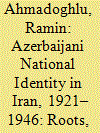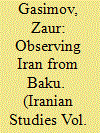| Srl | Item |
| 1 |
ID:
168854


|
|
|
|
|
| Summary/Abstract |
This article examines the roots and development of Azerbaijani identity in Iran. This study aims to demonstrate that the Azerbaijani minority in Iran lacked consciousness of a distinct national identity at the dawn of the twentieth century, and argues that the driving force behind the emergence of the consciousness of Azerbaijani national identity in Iran was the Pahlavi regime’s repressive and exclusivist nationalist policies between 1921 and 1941. Building upon the grievances of the Pahlavi era, the occupation of Iran by Allied forces during the Second World War and the short, Soviet-supported autonomy under the leadership of Sayyed Ja’far Pishevari in 1945–1946 institutionalized and consolidated the Azerbaijani Turkish identity in Iran.
|
|
|
|
|
|
|
|
|
|
|
|
|
|
|
|
| 2 |
ID:
186548


|
|
|
|
|
| Summary/Abstract |
Azerbaijani national identity emerged in post-Persian Russian-ruled East Caucasia at the end of the nineteenth century, and was finally forged during the early Soviet period. After the fiasco of the short-lived independence period of 1918–20, Azerbaijan became Soviet. Soviet power then instrumentalized Azerbaijan for political and ideological penetration into Iran by galvanizing local separatist movements. Azerbaijani Iranology was shaped within Soviet oriental studies and put into service of Azerbaijani nation-building. Exiled Iranian communists found asylum in Baku, joined local research institutions, wrote the first Persian academic and school textbooks, and contributed to the translation of classic Persian poetry into Azerbaijani. Soviet Azerbaijani Iranologists were sent as translators to the Soviet missions to Iran and Afghanistan. After Azerbaijan regained independence in 1991, its Iranological infrastructure was represented by several departments at the National Academy of Sciences and the Iranian Studies Program at Baku State University. While the number of Persian classes at schools during the last three decades diminished, a new generation of post-Soviet Iranologists—those who studied in Iran—emerged. While Soviet Azerbaijani Iranologists never created a solid bilingual dictionary of Persian, several Persian–Azerbaijani and Azerbaijani–Persian dictionaries were published in the 2010s. Post-Soviet Azerbaijani Iranology is still trying to find its place within humanities in the transitional nation.
|
|
|
|
|
|
|
|
|
|
|
|
|
|
|
|